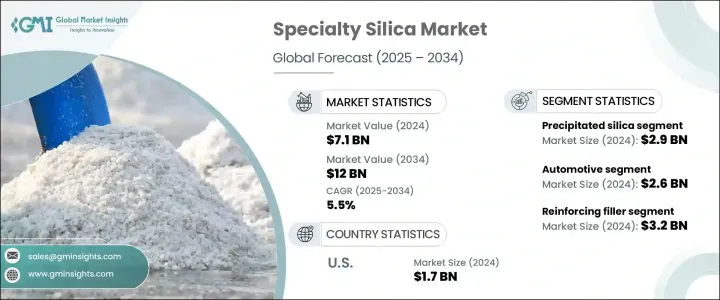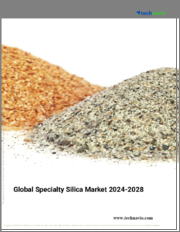
|
시장보고서
상품코드
1721475
특수 실리카 시장 기회, 성장 촉진요인, 산업 동향 분석 및 예측(2025-2034년)Specialty Silica Market Opportunity, Growth Drivers, Industry Trend Analysis, and Forecast 2025 - 2034 |
||||||
세계의 특수 실리카 시장은 2024년 71억 달러로 평가되었으며 CAGR 5.5%를 나타내 2034년에는 120억 달러에 이를 것으로 예측됩니다. 이러한 재료는 광범위한 기능성을 제공하기 위해 건축, 자동차, 일렉트로닉스, 퍼스널케어, 헬스 케어 등 다양한 산업에서 필수적인 요소가 되고 있습니다. 특수 실리카는 다양한 용도로 최적의 결과를 가져오는 능력으로 지지를 받고 있습니다. 특히 신흥 경제 국가에서는 지속가능성이 제조업체의 중심적인 초점이 되고 있으며, 고순도, 열안정성, 기계적 강도의 향상 등 특수 실리카의 특성은 앞으로 진정한 배합에 널리 활용되고 있습니다. 또한 친환경 제조방법에 대한 규제 당국의 지원과 반도체나 리튬 이온 전지 등의 하이테크 용도로의 실리카의 통합이 진행되고 있는 것도 시장 전망을 더욱 강화하고 있습니다.

시장 확대의 주요 요인은 지속 가능한 자동차 솔루션으로의 변화 증가입니다. 전기자동차(EV)가 세계적으로 기세를 늘리면서 가볍고 에너지 효율적인 재료에 대한 수요가 가속화되고 있습니다. 특수 실리카는 타이어 성능 최적화, 특히 구름 저항을 줄이고 연비를 향상시키는 녹색 타이어 제조에 중요한 역할을 합니다. 특히 침전 실리카는 타이어의 내구성과 효율을 높이기 위해 널리 사용되고 있으며, 미래의 이동성에 중요한 재료가 되었습니다. 건설 분야에서도 특히 성능과 지속가능성을 높이기 위해 고안된 고급 코팅제, 밀봉제 및 접착제에 대한 수요가 급증하고 있습니다.
| 시장 범위 | |
|---|---|
| 시작 연도 | 2024년 |
| 예측 연도 | 2025-2034년 |
| 시작 금액 | 71억 달러 |
| 예측 금액 | 120억 달러 |
| CAGR | 5.5% |
특수 실리카 시장은 유형별로 흄드 실리카, 콜로이드 실리카, 용융 실리카, 침전 실리카, 실리카겔 등으로 구분됩니다. 2024년, 침전 실리카 부문은 29억 달러를 차지했으며, 그 주된 이유는 녹색 타이어 제조에서 광범위한 사용으로 인한 것이었습니다. 이 재료는 연비 효율을 높이고 저 배출 가스 수송을 향한 업계의 뒷받침을 지원합니다. 흄드 실리카는 일렉트로닉스, 코팅, 접착제로 계속 각광을 받고 있으며, 콜로이드 실리카는 정밀 주조나 반도체 용도로 채용이 확대되고 있습니다. 건조제로 널리 사용되는 실리카 겔과 광학 용도에 필수적인 용융 실리카도 안정적인 수요 성장을 보여줍니다.
용도별로는 보강필러, 증점제, 고결방지제, 건조제, 촉매가 시장에 포함되어 있습니다. 보강 필러 카테고리만으로도 2024년에는 32억 달러의 매출을 기록했으며, 2034년까지의 CAGR은 5.5%를 나타낼 것으로 예상됩니다. 실리카의 주요 용도는 여전히 녹색 타이어의 제조이며 내구성 향상과 구름 저항 감소를 실현합니다. 실리카는 또한 접착제, 페인트, 코팅제의 증점제로도 널리 이용되고 있으며, 식품이나 의약품에서는 건조제나 고결방지제로서의 역할이 시장가치를 높이고 있습니다.
미국의 특수 실리카 시장은 2024년 17억 달러에 이르렀으며, 자동차 및 건설 분야의 친환경 솔루션에 대한 강한 수요가 성장을 지원하고 있습니다. 접착제나 코팅제와 같은 실리카 베이스의 건축자재와 함께, 그린 타이어에의 침전 실리카의 채용이 지역 확대의 원동력이 되고 있습니다. 또한 북미에서는 식품과 의약품 포장에 실리카의 사용량이 증가하고 있으며, 반도체 및 일렉트로닉스의 기술 혁신이 북미 시장에서의 존재감을 한층 더 높이고 있습니다.
세계의 특수 실리카 시장 주요 기업으로는 후지 실리시아 화학, Nouryon, Qemetica, Evonik Industries, Tata Chemicals, Imerys, Denka Company, Wacker Chemie, Madhu Silica, 3M, Cabot, Oriental Silicas 등이 있습니다. 이 회사는 진화하는 최종 사용자의 요구에 맞는 선진적이고 지속 가능한 실리카 제품을 개발하기 위해 연구 개발에 많은 투자를 실시했습니다.
목차
제1장 조사 방법과 범위
제2장 주요 요약
제3장 업계 인사이트
- 생태계 분석
- 밸류체인에 영향을 주는 요인
- 이익률 분석
- 파괴적 혁신
- 향후 전망
- 제조업체
- 유통업체
- 공급업체의 상황
- 이익률 분석
- 주요 뉴스와 대처
- 규제 상황
- 영향요인
- 성장 촉진요인
- 자동차 업계에서 침강 실리카를 사용한 그린 타이어의 채용 증가
- 건설 활동의 확대에 의해 도료, 코팅제, 접착제에 있어서 실리카 수요 증가
- 실리카 기반 부형제 및 헬스케어 포장용 의약품의 성장세
- 업계의 잠재적 위험 및 과제
- 실리카 생산 비용에 영향을 미치는 원재료 가격의 변동
- 제조 중 실리카 분진 노출과 관련된 환경 우려
- 성장 촉진요인
- 성장 가능성 분석
- Porter's Five Forces 분석
- PESTEL 분석
제4장 경쟁 구도
- 서론
- 기업 시장 점유율 분석
- 경쟁 포지셔닝 매트릭스
- 전략적 전망 매트릭스
제5장 시장 추계·예측 : 유형별(2021-2034년)
- 주요 동향
- 침전 실리카
- 퓸드 실리카
- 콜로이드 실리카
- 용융 실리카
- 실리카겔
- 기타
제6장 시장 추계·예측 : 용도별(2021-2034년)
- 주요 동향
- 강화 필러
- 증점제
- 고결 방지제
- 건조제
- 촉매제
- 기타
제7장 시장 추계·예측 : 최종 이용 산업별(2021-2034년)
- 주요 동향
- 자동차
- 건설
- 식품 및 음료
- 제약 및 헬스케어
- 기타
제8장 시장 추계·예측 : 지역별(2021-2034년)
- 주요 동향
- 북미
- 미국
- 캐나다
- 유럽
- 독일
- 영국
- 프랑스
- 스페인
- 이탈리아
- 네덜란드
- 아시아태평양
- 중국
- 인도
- 일본
- 호주
- 한국
- 라틴아메리카
- 브라질
- 멕시코
- 아르헨티나
- 중동 및 아프리카
- 사우디아라비아
- 남아프리카
- 아랍에미리트(UAE)
제9장 기업 프로파일
- 3M
- Cabot
- Denka Company
- Evonik Industries
- Fuji Silysia Chemical
- Imerys
- Madhu Silica
- Nouryon
- Oriental Silicas
- Qemetica
- Tata Chemicals
- Wacker Chemie
The Global Specialty Silica Market was valued at USD 7.1 billion in 2024 and is estimated to grow at a CAGR of 5.5% to reach USD 12 billion by 2034. This upward trajectory is primarily driven by the increasing demand for high-performance materials such as fumed silica, colloidal silica, silica gel, and precipitated silica. These materials offer a broad spectrum of functionalities, making them indispensable across multiple industries, including construction, automotive, electronics, personal care, and healthcare. With industries placing greater emphasis on product durability, energy efficiency, and eco-friendliness, specialty silica continues to gain traction for its ability to deliver optimal results across varied applications. As sustainability becomes a central focus for manufacturers, especially in developed economies, specialty silica's properties-like high purity, thermal stability, and enhanced mechanical strength-are being widely leveraged in advanced formulations. Furthermore, regulatory support for greener manufacturing practices and the increasing integration of silica into high-tech applications, including semiconductors and lithium-ion batteries, further strengthen the market outlook.

A key contributor to the market's expansion is the rising shift toward sustainable automotive solutions. As electric vehicles (EVs) gain momentum worldwide, the demand for lightweight, energy-efficient materials is accelerating. Specialty silica plays a vital role in optimizing tire performance, especially in the production of green tires that offer reduced rolling resistance and improved fuel economy. Precipitated silica, in particular, is extensively used to enhance tire durability and efficiency, positioning it as a critical material for the future of mobility. The construction sector is also witnessing a surge in specialty silica demand, especially for advanced coatings, sealants, and adhesives designed to deliver greater performance and sustainability.
| Market Scope | |
|---|---|
| Start Year | 2024 |
| Forecast Year | 2025-2034 |
| Start Value | $7.1 Billion |
| Forecast Value | $12 Billion |
| CAGR | 5.5% |
The specialty silica market is segmented by type into fumed silica, colloidal silica, fused silica, precipitated silica, silica gel, and others. In 2024, the precipitated silica segment accounted for USD 2.9 billion, largely due to its widespread usage in green tire manufacturing. The material enhances fuel efficiency and supports the industry's push toward low-emission transport. Fumed silica continues to gain prominence in electronics, coatings, and adhesives, while colloidal silica finds growing adoption in precision casting and semiconductor applications. Silica gel, widely used as a desiccant, and fused silica, essential for optical applications, are also experiencing steady demand growth.
Based on application, the market covers reinforcing fillers, thickening agents, anti-caking agents, desiccants, and catalysts. The reinforcing filler category alone generated USD 3.2 billion in 2024 and is expected to grow at a CAGR of 5.5% through 2034. Its primary use remains in green tire production, offering enhanced durability and reduced rolling resistance. Silica is also widely utilized as a thickening agent in adhesives, paints, and coatings, while its role in food and pharma as a desiccant and anti-caking agent adds to its market value.
The U.S. Specialty Silica Market reached USD 1.7 billion in 2024, with growth supported by strong demand for eco-friendly solutions in the automotive and construction sectors. The adoption of precipitated silica for green tires, along with silica-based construction materials like adhesives and coatings, drives regional expansion. The country also sees rising silica usage in food and pharmaceutical packaging, while innovations in semiconductors and electronics further strengthen market presence across North America.
Key players in the global specialty silica market include Fuji Silysia Chemical, Nouryon, Qemetica, Evonik Industries, Tata Chemicals, Imerys, Denka Company, Wacker Chemie, Madhu Silica, 3M, Cabot, and Oriental Silicas. These companies are heavily investing in R&D to develop advanced, sustainable silica products tailored to evolving end-user requirements. Strategic acquisitions, technological collaborations, and manufacturing upgrades remain central to their efforts to improve competitiveness and expand into high-growth markets worldwide.
Table of Contents
Chapter 1 Methodology and Scope
- 1.1 Market scope and definition
- 1.2 Base estimates and calculations
- 1.3 Forecast calculation
- 1.4 Data sources
- 1.4.1 Primary
- 1.4.2 Secondary
- 1.4.2.1 Paid sources
- 1.4.2.2 Public sources
- 1.5 Primary research and validation
- 1.5.1 Primary sources
- 1.5.2 Data mining sources
Chapter 2 Executive Summary
- 2.1 Industry synopsis, 2021-2034
Chapter 3 Industry Insights
- 3.1 Industry ecosystem analysis
- 3.1.1 Factor affecting the value chain
- 3.1.2 Profit margin analysis
- 3.1.3 Disruptions
- 3.1.4 Future outlook
- 3.1.5 Manufacturers
- 3.1.6 Distributors
- 3.2 Supplier landscape
- 3.3 Profit margin analysis
- 3.4 Key news and initiatives
- 3.5 Regulatory landscape
- 3.6 Impact forces
- 3.6.1 Growth drivers
- 3.6.1.1 Rising adoption of green tires using precipitated silica in the automotive industry
- 3.6.1.2 Expanding construction activities driving demand for silica in paints, coatings, and adhesives
- 3.6.1.3 Growth in pharmaceuticals for silica-based excipients and healthcare packaging
- 3.6.2 Industry pitfalls and challenges
- 3.6.2.1 Volatility in raw material prices affecting silica production costs
- 3.6.2.2 Environmental concerns related to silica dust exposure during manufacturing
- 3.6.1 Growth drivers
- 3.7 Growth potential analysis
- 3.8 Porter’s analysis
- 3.9 PESTEL analysis
Chapter 4 Competitive Landscape, 2024
- 4.1 Introduction
- 4.2 Company market share analysis
- 4.3 Competitive positioning matrix
- 4.4 Strategic outlook matrix
Chapter 5 Market Estimates and Forecast, By Type, 2021 – 2034 (USD Billion) (Kilo Tons)
- 5.1 Key trends
- 5.2 Precipitated silica
- 5.3 Fumed silica
- 5.4 Colloidal silica
- 5.5 Fused silica
- 5.6 Silica gel
- 5.7 Others
Chapter 6 Market Estimates and Forecast, By Application, 2021 – 2034 (USD Billion) (Kilo Tons)
- 6.1 Key trends
- 6.2 Reinforcing filler
- 6.3 Thickening agent
- 6.4 Anti-caking agent
- 6.5 Desiccants
- 6.6 Catalyst
- 6.7 Others
Chapter 7 Market Estimates and Forecast, By End Use Industry, 2021 – 2034 (USD Billion) (Kilo Tons)
- 7.1 Key trends
- 7.2 Automotive
- 7.3 Construction
- 7.4 Food and beverage
- 7.5 Pharmaceuticals and healthcare
- 7.6 Others
Chapter 8 Market Estimates and Forecast, By Region, 2021 – 2034 (USD Billion) (Kilo Tons)
- 8.1 Key trends
- 8.2 North America
- 8.2.1 U.S.
- 8.2.2 Canada
- 8.3 Europe
- 8.3.1 Germany
- 8.3.2 UK
- 8.3.3 France
- 8.3.4 Spain
- 8.3.5 Italy
- 8.3.6 Netherlands
- 8.4 Asia Pacific
- 8.4.1 China
- 8.4.2 India
- 8.4.3 Japan
- 8.4.4 Australia
- 8.4.5 South Korea
- 8.5 Latin America
- 8.5.1 Brazil
- 8.5.2 Mexico
- 8.5.3 Argentina
- 8.6 Middle East and Africa
- 8.6.1 Saudi Arabia
- 8.6.2 South Africa
- 8.6.3 UAE
Chapter 9 Company Profiles
- 9.1 3M
- 9.2 Cabot
- 9.3 Denka Company
- 9.4 Evonik Industries
- 9.5 Fuji Silysia Chemical
- 9.6 Imerys
- 9.7 Madhu Silica
- 9.8 Nouryon
- 9.9 Oriental Silicas
- 9.10 Qemetica
- 9.11 Tata Chemicals
- 9.12 Wacker Chemie



















